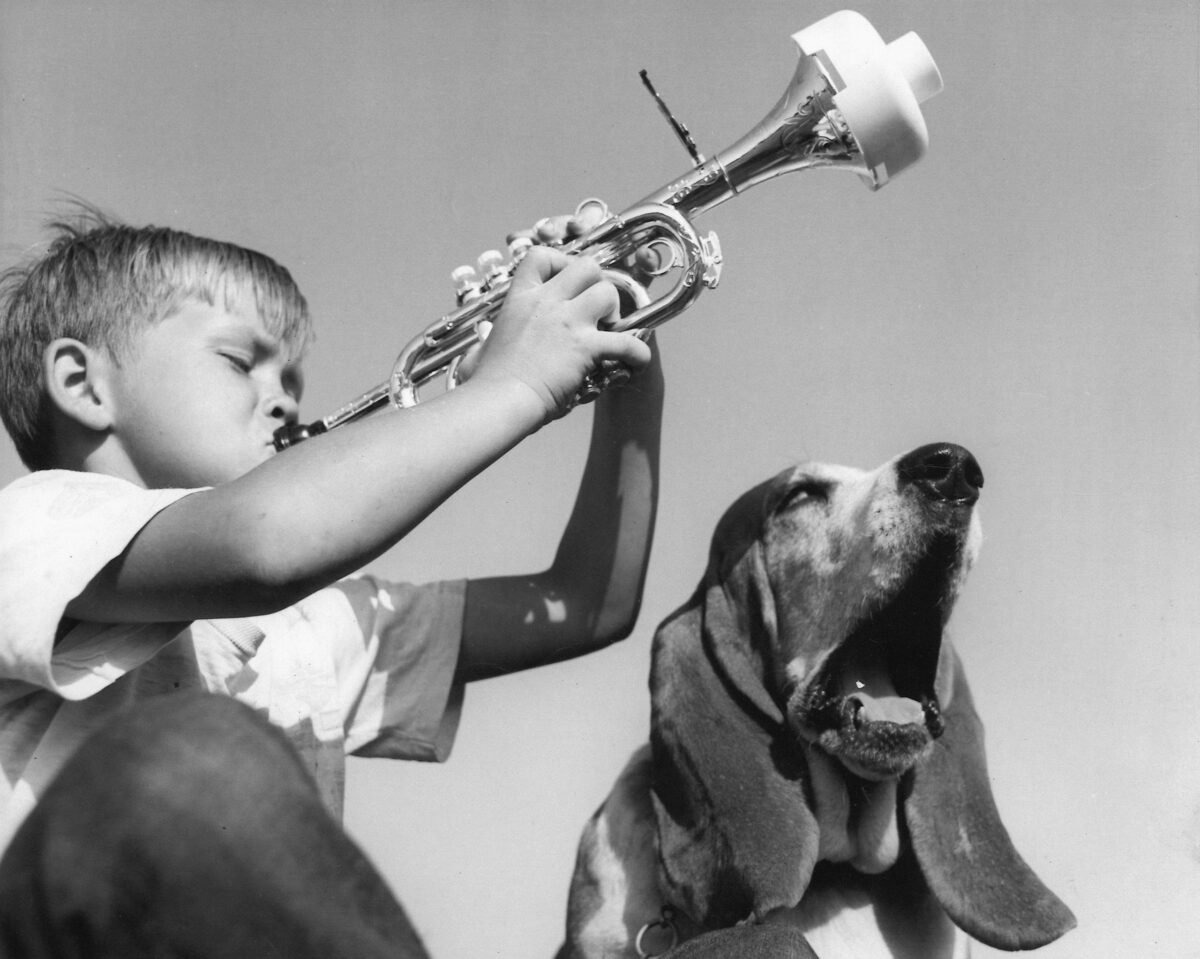Spotify For Good Boys: How Music Really Affects Your Dog’s Mood
When you purchase through links on our site, we may earn a commission. Here’s how it works.
Ever notice your dog chilling out to Norah Jones or losing their mind to Metallica? Turns out, your pup’s got taste.
Table of Contents
Studies show music doesn’t just soothe the human soul; it literally changes how dogs feel, sleep, and even behave. Let’s press play on what’s happening inside those floppy-eared little heads and explore the best music picks for your pup.

The Science Behind Music & Mood
Music affects the body in measurable ways. When people listen to music they enjoy, the brain releases dopamine, the chemical tied to happiness and reward. At the same time, cortisol levels drop, which helps reduce tension and slow the heart rate.
Dogs react in similar ways, but their hearing range is higher and more sensitive. Low-tempo sounds and gentle melodies relax them, while sudden or high-pitched noises can cause stress.
Shelter studies found that classical and reggae increased relaxation and reduced barking, whereas hard rock increased barking and agitation. The right playlist can literally help a dog’s body and brain reset after stress.
Quick Takeaway
- In humans, music lowers cortisol, boosts dopamine, and supports heart health
- In dogs, classical and reggae promote calm, while hard rock triggers stress
- Consistent rhythm and slower tempo help both species relax
How Dogs Hear Music
Dogs experience music in a completely different way than humans. Their hearing range extends from about 47,000 to 65,000 Hz — much higher than ours — which means they can detect frequencies and overtones we can’t even perceive.

Because of that sensitivity, certain high-pitched or sharp sounds can feel uncomfortable, even if they sound fine to us. Volume and distance matter more to dogs, too. A song that seems soft to you might feel louder or more intense to them, depending on the pitch and where they’re sitting.
Dogs also rely on rhythm and repetition more than melody. That’s why predictable beats or slower tempos tend to calm them, while abrupt, fast, or inconsistent rhythms can create stress or restlessness.
Quick Takeaway
- Dogs hear higher frequencies than humans
- Volume, pitch, and rhythm shape their experience
- Calm, predictable sounds tend to be most soothing
Can Dogs Actually Enjoy Music?
Dogs may not understand melody, but they respond to sound in ways that feel familiar to us. A change in pitch, rhythm, or tone can trigger curiosity, calm, or full-blown excitement.
When a favorite song plays, some dogs spring to life. This Golden Retriever perks up the second he hears his favorite tune, ears forward and tail wagging, before taking off in full-blown zoomies.
Scientists think these reactions come from how dogs process vibration and frequency. They hear higher ranges than we do, so music hits their brains differently. A soothing rhythm can slow breathing, while sharper notes can stir excitement.
Bradford the dog loves music. He closes his eyes and relaxes completely as his owner plays piano, showing how slower tempos can put dogs at ease.
Whether it’s zoomies or zen, these reactions show that dogs feel music on their own terms. They may not “like” songs the way humans do, but sound clearly shapes their moods and behavior.
And of course, some dogs simply can’t help but sing along when the music hits the right notes.
Quick Takeaway
- Dogs respond physically and emotionally to rhythm and tone
- Exciting tempos can spark play, while slower ones promote calm
- Their reactions mirror ours more than we might expect
What Music Really Does For Humans
Music’s effects on people are among the most studied topics in psychology and neuroscience. Listening to songs we enjoy triggers the release of dopamine, which boosts mood and motivation. At the same time, cortisol levels drop, reducing stress and tension.
Research shows that positive or preferred music improves mood, reduces stress, and can even boost brain function. Slow, steady rhythms can lower heart rate and blood pressure. And, soothing melodies before bed can improve sleep quality by calming the nervous system.
Music therapy has also been used to manage pain, ease symptoms of depression, and improve memory and focus in older adults.
In other words, music is more than entertainment. It’s a full-body regulator that lowers blood pressure, eases pain, and helps people feel calmer and more connected.
These effects aren’t limited to one genre. It’s the tempo, tone, and emotional connection that determine the outcome, whether it’s a symphony or a favorite playlist.
Quick Takeaway
- Music lowers cortisol, blood pressure, and heart rate
- Dopamine release boosts mood and focus
- Calming songs before bed can improve sleep quality
- Music therapy helps reduce pain and depression
For humans, the healing power of music is clear. For dogs, the research is newer, but what we’ve learned so far is fascinating.
What Music Really Does For Dogs
Dogs don’t experience music the same way humans do, but researchers agree it can influence their mood and behavior. In a review of nine studies on auditory enrichment in dogs, six found measurable behavioral changes when music was played. The strongest and most consistent results came from calm, low-tempo genres.
1. Promotes Calm Behavior
Classical music consistently helps dogs settle down. Dogs exposed to this genre spend more time lying quietly and less time barking, pacing, or standing at alert.

Variety matters. Dogs can become desensitized to a single playlist after a few days, so rotating tracks keeps the soothing effect intact. Mixing up genres also helps prevent dogs from getting bored with the music and losing the calming effect.
Fun Fact: One study found that audiobooks could be even more effective than music. Dogs who listened to recorded stories showed calmer behavior than dogs exposed to any musical genre, including classical music.
2. Eases Stressful Reactions
Music in general helps keep dogs calmer and less stressed. Several studies saw changes in heart rate variability when music was played, a sign of reduced stress; however, cortisol, a stress hormone, showed more inconsistent results.

In one study that compared different genres, kenneled dogs exposed to any genre of music showed more relaxed behavior overall. As a caveat, heavy metal, rock, or loud, fast-paced music sometimes caused more barking and movement.
While soothing sounds can’t erase fear, they may help dogs recover more quickly after stressful events such as thunderstorms, fireworks, or noisy environments.
Did You Know? “Dog-specific” relaxing music doesn’t always beat classical. Across multiple studies, including five that tested the popular “Through a Dog’s Ear” series, dogs did not show significantly more relaxation than they did with random selections of classical music.
3. Encourages Rest
In multiple shelter studies, dogs exposed to classical or soft rock spent more time lying down and less time standing or pacing. Quiet background sound seems to promote the kind of stillness that encourages sleep and recovery.

Researchers note that the benefit can fade over time if the same playlist repeats too often. Switching between genres or alternating with audiobooks can keep dogs engaged while maintaining the relaxing effect.
Music may also help dogs settle after active play or stressful experiences, such as vet visits or car rides. For many, it acts as a cue that the day is winding down.
Note: Individual variation and preference matter. Different dogs — based on age, breed, and past experiences — respond in their own ways.
What relaxes one dog might not relax another. Physical differences, such as ear shape and hearing sensitivity, can also influence how music is perceived.
4. Helps Focus
While most research has focused on music’s calming effects, some findings suggest it can also influence alertness. A study on tempo and pitch modification found that low-frequency tracks increased alertness in some dogs, showing that how a song is composed — not just its genre — can shape behavior.

This result may have practical uses in training environments. Low-pitch or steady-tempo music could help dogs stay engaged and focused during learning sessions, while overly stimulating tracks might make it harder for them to concentrate.
Training Tip: Because every dog processes sound differently, trial and observation are key. Trainers and pet parents can experiment with calm but rhythmic background music to find what keeps their dog alert yet relaxed.
How To Create a Shared Playlist
You don’t need to be a DJ to find your dog’s favorite songs. Start with calm, low-tempo music. Classical and reggae genres typically promote relaxation without overstimulation.
From there, experiment. Try alternating between slower songs for downtime and a few livelier tracks for play or training.
If your dog seems bored after a few days, switch genres or shuffle your playlist — studies show variety helps prevent the effects from fading.
Still not sure where to start? Check out Spotify’s “Relaxing Music for Dogs” playlist.
Tips For Building Your Dog’s Playlist
- Mix it up: Alternate between calm and mid-tempo tracks.
- Watch reactions: Tail wags, relaxed posture, or quiet settling are good signs.
- Avoid extremes: Skip loud or high-intensity music.
- Test timing: Use calming tracks before bed and upbeat ones before walks.
The Bond Boost: Why Listening Together Matters
Music does more than fill the silence — it can create a shared sense of calm. In people, synchronized rhythms and musical interaction are known to promote social bonding and emotional connection.
Although research on dogs is still limited, similar patterns of emotional alignment have been observed. Studies suggest that dogs and their owners can experience synchronized changes in heart rate and stress levels during positive interactions. While we can’t say music causes this directly, it may help create the kind of relaxed environment where bonding naturally occurs.
It doesn’t have to be classical or “dog-specific” music. What matters most is consistency. When the music starts and you both settle in, it becomes a cue that the world can slow down for a while — together.

My Personal Experience: The Mosh Pit Sessions
When I adopted my Golden Retriever, Rio, he was shy and unsure of himself. To help him loosen up, I started what I jokingly call our “Mosh Pit Sessions.”
There’s no playlist or structure — just upbeat music, a cleared patch of floor, and lots of jumping around. I’ll turn on something with energy and dance around while Rio jumps, spins, and zooms in wild circles.
The first few times, he looked confused. Now, the second I say “Mosh Pit,” his tail starts wagging. He knows it’s time for play.
Those short bursts of chaos have become our ritual. They help him burn off energy and connect with me in a way words never could. For Rio, the right beat isn’t calming; it’s confidence-building.
Frequently Asked Questions
Before you hit play, here are a few of the most common questions pet parents ask about dogs and music, from volume settings to how long you should leave the playlist running.
Don’t see your question? Ask us in the comments!
What Kind Of Music Do Dogs Like Most?
We don’t really know. Studies suggest that dogs have personal preferences, just like humans. Some dogs relax to classical or reggae, while others perk up at acoustic or pop.
Research shows that while classical music often helps calm behavior, that doesn’t mean it’s a dog’s favorite genre. Every pup processes rhythm and tone differently, so finding what works best usually takes a bit of experimenting.
For variety, alternate between music and audiobooks. Dogs appear to enjoy the sound of human voices, and switching things up can keep them from tuning the music out.
Can I Leave Music On When I’m Not Home?
Yes, as long as the volume is low and the music is calm. Background music can help mask outside noises that might otherwise startle or stress your dog.
Avoid leaving loud or high-energy tracks on repeat, as they can have the opposite effect.
What’s The Best Volume For Calming Music?
Keep it at a gentle, conversational level — around 50–60 decibels. If you have to raise your voice to talk over it, it’s too loud for your dog’s more sensitive hearing.
Do Dogs Get Bored Of The Same Songs?
They can. Research suggests that dogs may become habituated to the same playlist over time, which reduces its effect.
Switching genres or changing songs every couple days keeps their interest and maintains results.
Does White Noise Work The Same Way As Music?
No. White noise can help block sudden sounds, but it doesn’t appear to have the same mood or relaxation benefits as structured music. It can still be useful for dogs sensitive to outside noise, especially in urban settings.
Is “Dog Music” Really Better Than Regular Music?
Not necessarily. Multiple studies found that dogs exposed to specially marketed “dog relaxation” music didn’t show greater calmness than those who listened to classical tracks. Variety and tempo matter most.
Keep The Good Vibes Going
Want more ways to help your dog chill out? Check out our guide to the best TV and music for dogs. Or peek at noise-canceling headphones for dogs to block out chaos and let your dog relax in peace.



